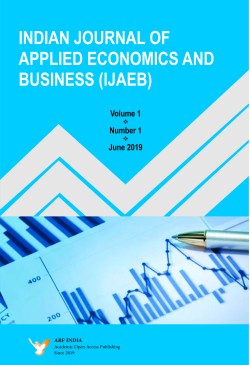
Indian Journal of Applied Economics and Business
Frequency :Bi-Annual
ISSN :2582-4325
Peer Reviewed Journal
Adoption and Determinants of Task Force on Climate-related Financial Disclosures (TCFD) Reporting Frameworks by Australian Stock Exchange (ASX) Listed Companies
Mother's Education and Child Health in India: Multinomial Logit Estimation of Malnutrition
Tail-risk Dependence Networks in the US Commodity Sectors. Has Covid-19 Made A Thing?
Dimitra Tzaferi (2023). Tail-risk Dependence Networks in the US Commodity Sectors. Has Covid-19 Made A Thing? Indian Journal of Applied Economics and Business. 5(1), 37-67. https://DOI:10.47509/IJAEB.2023.v05i01.03
Factors Determining Balance of Trade in India
This paper aims to determine the major factors influencing Balance of Trade (BoT) of India over the last 40 years (1981-2019). The OLS method of regression analysis has been used in the paper to analyse the relationship between balance of trade of India and its determinants. It is found that four main factors influence balance of trade in India-Real Effective Exchange Rate (REER), real value of global crude oil prices, private investment in India, and GDP per capita of India. Global oil prices have a significant negative relationship with India’s trade balance. Investment, REER and GDP per capita have a significant positive relationship with India’s trade balance. Furthermore, trade balance of India has been exceptionally low in two years - 2011 and 2017 - mainly due to global financial crisis and global recession respectively. These years are captured by dummy variables in the regression model.
???????Keywords: Balance of Trade, Exchange rate, Exports and imports, Trade balance of India, International trade.
Yusra Anees (2023). Factors Determining Balance of Trade in India. Indian Journal of Applied Economics and Business. 5(1), 69-84. https://DOI:10.47509/IJAEB.2023.v05i01.04
Sustainability and Dietary Change: An Analysis of Indian Food Consumption Patterns
Redesigning Crop Insurance for Coping with Climate Change in India
The Determinants of Public Goods Provision: An Empirical Evidence From the Major States of India
Investment and Employment Generation in Micro-enterprises of North Karnataka: An Analysis in Registered Manufacturing and Service Micro-enterprises
Remittance of Indian Immigrants: Catalytic for Socio-economic Development
The Impact of Covid– 19 Pandemic on Apparel Exports: Evidence from Sri Lanka
A Review of Earlier Works on Time Poverty Around the World: A Period From 2000 to 2018
Women Empowerment and SHGs in Odisha: A Case Study of Bhadrak District
Mamata Panda and L.N. Das (2023). Women Empowerment and SHGs in Odisha: A Case Study of Bhadrak District. Indian Journal of Applied Economics and Business. 5(1), 215-227. https://DOI:10.47509/IJAEB.2023.v05i01.12